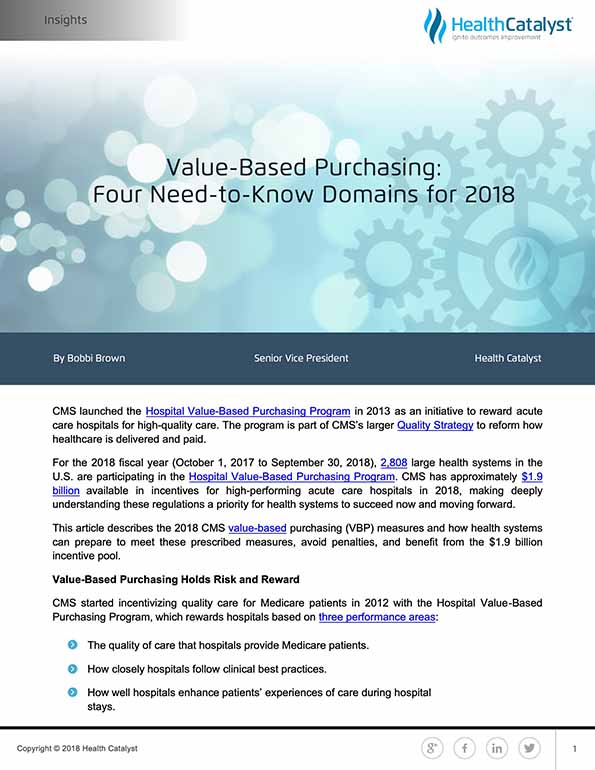Health systems that meet the 2018 Hospital Value-Based Purchasing Program measures stand to benefit from CMS’s $1.9 billion incentive pool. Under the 2018 regulations, CMS continues to emphasize quality. To reduce the risk of penalty and vie for bonuses, it’s increasingly critical that organizations leverage data to build skills and processes that meet more demanding reimbursement measures.
To thrive under value-based payment, healthcare systems must understand CMS’s four quality domains, and their associated measures, for 2018:
1. Clinical Care
2. Patient- and Caregiver-Centered Experience of Care/Care Coordination
3. Efficiency and Cost Reduction
4. Safety



CMS launched the Hospital Value-Based Purchasing Program in 2013 as an initiative to reward acute care hospitals for high-quality care. The program is part of CMS’s larger Quality Strategy to reform how healthcare is delivered and paid.
For the 2018 fiscal year (October 1, 2017 to September 30, 2018), 2,808 large health systems in the U.S. are participating in the Hospital Value-Based Purchasing Program. CMS has approximately $1.9 billion available in incentives for high-performing acute care hospitals in 2018, making deeply understanding these regulations a priority for health systems to succeed now and moving forward.
This article describes the 2018 CMS value-based purchasing (VBP) measures and how health systems can prepare to meet these prescribed measures, avoid penalties, and benefit from the $1.9 billion incentive pool.
CMS started incentivizing quality care for Medicare patients in 2012 with the Hospital Value-Based Purchasing Program, which rewards hospitals based on three performance areas:
Under VBP, organizations have the potential for upside or downside reimbursement. If their services meet performance measures in the four CMS quality domains (Clinical Care, Patient- and Caregiver-Centered Experience of Care/Care Coordination, Efficiency and Cost Reduction, and Safety), they will receive a bonus. If organizations fail to meet these thresholds for the measures, they will receive a penalty.
To fund quality incentives, CMS reduced base-operating Medicare Severity Diagnosis Related Groups (MS-DRG) payments by two percent. Leftover monies are redistributed to hospitals based on their Total Performance Scores (TPS); this measure will be covered below.
In the final regulations for 2018, CMS stated that the Hospital Value-Based Purchasing Program helps incentivize hospitals to improve healthcare quality and value. According to CMS, this program is a key component in connecting quality and improvement outcomes with payment. CMS annually adjusts the measures and their weighting (how much each measure impacts reimbursement).
Of the 2,808 acute care hospitals participating in the Hospital Value-Based Purchasing Program in 2018, CMS has penalized 1,211 (or 43 percent) of hospitals and awarded bonuses or breakeven status to 1,597 (57 percent) hospitals. The lowest adjustment penalty was negative 1.7 percent, and the highest bonus was 3.01 percent. More than 500 hospitals received a bonus greater than $100,000, and 1,150 hospitals received a penalty between .01 and .99 percent.
To establish domains, CMS uses measures that the Hospital Inpatient Quality Reporting (IRQ) Program has specified. The Hospital IQR Program makes these results available on Hospital Compare for one year.
CMS has four domains for 2018, each weighted 25 percent, and with corresponding measures:
Eight measures:
Seven measures:
Three measures:
One measure: Medicare Spending per Beneficiary (MSPB).
Health systems must note that, similar to the Hospital Value-Based Purchasing Program, the Hospital-Acquired Condition (HAC) Program (an initiative to reduce HACs) also includes safety measures in its calculation. Organizations can earn bonuses or penalties for safety performance in measures in the two programs.
CMS introduced the Patient- and Caregiver-Centered Experience of Care/Care Coordination section in 2018. Now, the Hospital Consumer Assessment of Healthcare Providers and Systems (HCAHPS) survey (the first national, standardized, publicly reported survey of patients’ perspectives on hospital care) will include the following three questions, which CMS believes will help assess an important component of quality in the acute care setting by helping hospitals understand patients’ experiences as they leave the facility:
Question #1. During this hospital stay, staff took my preferences and those of my family or caregiver into account in deciding what my healthcare needs would be when I left:
Question #2. When I left the hospital, I had a good understanding of the things I was responsible for in managing my health:
Question #3. When I left the hospital, I clearly understood the purpose for taking each of my medications:
CMS scores hospitals on either achievement (comparison to other hospitals) or improvement, awarding the hospital the higher of the two scores. Achievement is compared to a benchmark threshold, while the improvement score measures the performance compared to the baseline. For Patient- and Caregiver-Centered Experience of Care/Care Coordination, CMS uses consistency points: hospitals get a base score and then one point for achievement above the threshold.
The minimum reporting requirement to receive a Clinical Care domain score is 25 applicable claims for at least two of the three Clinical Care domain measures during the performance period. For HCAHPS surveys, a minimum of 100 HCAHPS surveys is required in the Patient- and Caregiver-Centered Experience of Care/Care Coordination domain during the performance period.
Each measure has a performance period and a baseline period. The performance period for 2018 measures ended in 2016, with exception of Safety (2015). For the Patient Safety indicator (PSI)-90 score, CMS used data from July 2010 to 2012. For Clinical Care, CMS calculated the current baseline with data from October 2009 to 2012. For the Safety (all measures except PSI-90), Patient- and Caregiver-Centered Experience of Care/Care Coordination, and Efficiency and Cost Reduction scores, CMS used data from 2014.
For each domain score, CMS takes the higher score (achievement or improvement score) and sum for the domain plus the consistency score for the Patient- and Caregiver-Centered Experience of Care/Care Coordination domain, then multiplies that score by domain weight. It then adds together the weighted domain scores to get the TPS. CMS then creates an adjustment factor, which is applied (plus or minus) to the payment amount for each MP-DRG in 2018.
Each May, CMS makes performance available to healthcare providers via a secure portal on QualityNet. CMS also releases to the public the measures used to establish the performance on the Hospital Compare website. CMS released data on December 21, 2017, on Hospital Compare to show the 2018 measures and scores by hospital. This public data sharing gives organizations another incentive to prioritize quality.
Lowering cost is critical because, unlike other domains that have several metrics that factor into scores, the MSPB metric is the only cost metric and is weighted at 25 percent of the total score.
MSPB is a publicly available cost measure that shows how a health system ranks compared with others for spending on each Medicare patient. Organizations can examine their total Medicare costs (from hospitals and skilled nursing facilities [SNFs]) to determine areas to investigate.
CMS pulled together Medicare Part A (hospital expenses) and Part B (health insurance) claims and displayed the dollars representing claims paid from three days prior to admission through 30 days after discharge. They standardize the payment amounts by removing the effect of geographic payment differences and add-on payments (e.g., direct and indirect graduate medical education).
The MSPB measure shows a health system’s efficiency relative to the efficiency of the median hospital in the same state and by national comparison. The threshold used to determine the achievement scoring for this measure is the national standardized median.
The 2018 rule finalizes the following changes to the VBP measures in future years, which will continue to push quality:
On April 24, 2018, CMS released the fiscal year 2019 Inpatient Prospective Payment System (IPPS) proposed payment rule. The proposal lists several changes for the Hospital Value-Based Purchasing Program, including the elimination of several sets of measures by 2021. CMS is moving to a more manageable set of measures and would like to reduce the burden of collecting measures:
CMS modeled the impact of these changes on domain weighting. The percent of hospitals receiving a positive payment adjustment would decline from 57 percent to 45 percent. The proposal is now in the comment period until June 25,2018.
In addition, the Medicare Payment Advisory Commission (MEDPAC) has released a recommendation to Congress that would create a new Hospital Value Incentive Program (HVIP) that would merge two programs: the Hospital Readmission Reduction Program and the Hospital Value-Based Purchasing Program. The merger would eliminate the IRQ and HAC Programs to remove existing overlap. HVIP would aim to avoid the disparities in payment adjustments that arise from serving different patient populations. With the proposed regulations for 2019, CMS is starting to implement this recommendation. HVIP would have four main areas:
Using data as their most strategic asset, health systems can thrive under VBP. Analytic-driven technologies, such as the following examples from Health Catalyst, can help organizations optimize their opportunities for incentives, avoid penalties, and position themselves for CMS’s increasing focus on quality.
Based on the CMS Hospital Value-Based Purchasing Program measures for 2018 and scheduled changes through 2022, health systems must prepare for the continued emphasis on quality and rising quality standards around reimbursement measures. Organizations can reduce their risk of penalty and increase their chance of earning incentive bonuses by understanding the four current CMS quality domains (Clinical Care, Patient- and Caregiver-Centered Experience of Care/Care Coordination, Efficiency and Cost Reduction, and Safety) and building the skills and process to handle increasingly stricter quality measures in these areas.
Would you like to learn more about this topic? Here is an article we suggest:
The Key to Transitioning from Fee-for-Service to Value-Based Reimbursement
Would you like to use or share these concepts? Download this presentation highlighting the key main points.
Click Here to Download the Slides
https://www.slideshare.net/healthcatalyst1/valuebased-purchasing-four-needtoknow-domains-for-2018